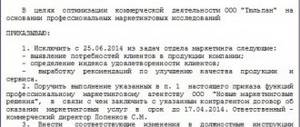Author of the article: Anastasia Ivanova Last modified: January 2021 145191
Optimizing a company often leads to a reduction in the number of employees. Losing a position is an unpleasant event for a person. Reductions at work are often carried out with violations, and instead of thanking management for years of activity, the employee is left with nothing. To avoid negative consequences, a person must know about his rights and be able to defend them.
Basic Concepts
The reduction procedure is carried out in strict accordance with the Labor legislation of the Russian Federation. According to regulations, there are two grounds for dismissing an employee:
- Reorganization of the company, due to which the number of jobs is reduced;
- Reduction of staff.
Job losses usually occur for economic reasons. However, the staffing table remains the same. For example, out of five people holding the position of sales manager, two are retained.
When staffing is reduced, the position is completely eliminated. For example, the responsibilities of a HR employee are transferred to an accountant.
Expert commentary
Kamensky Yuri
Lawyer
The reduction is due to adjustments to the staffing table. During the procedure, new amendments are made to the current document. The manager is obliged to familiarize employees with changes in the staffing table. In addition, the director issues an order explaining the reasons for the reduction.
Payments and final settlement
Each person who previously held the post of head of the company is paid monetary compensation upon dismissal, provided that the reason for the termination of cooperation was not due to guilty actions. This rule is regulated by Article 279 of the Labor Code of Russia. At the same time, the amount of payments that a person will receive must be specified in the employment contract. In the absence of such information in the agreement, the amount of payments is determined by the general meeting of founders and is reflected in the minutes.
When determining the amount of cash payment, it is necessary to take into account a number of nuances:
- the person's long-term work in the position he or she occupies;
- what period of time remains before the expiration of the employment contract, if it is urgent;
- the amount of wages that a person could receive if not for the reduction procedure;
- the presence or absence of additional expenses that a person may incur in the event of termination of the employment contract.
It is important to know! Current legislation does not establish a maximum amount of payments that a former director can receive. In this case, the minimum threshold is three times the average wage of a person. The amount of payment may be challenged in court. Besides. If the court decides that the amount of the payment is too large, which will lead to a violation of the interests of the organization or other employees, then it can reduce it.
Often, the founders of a company decide to carry out the procedure for dismissing the director of the enterprise. This procedure is fully regulated by labor legislation. This procedure differs from ordinary layoffs in that the basis for dismissal is not an order, but the minutes of the meeting of the founders. A full settlement must be made with the person with the issuance of wages, money for unused vacation and compensation, the amount of which is determined individually.
Reduction instructions
Article 180 of the Labor Code of the Russian Federation describes the procedure for reducing employees. If the conditions are not met or the rights of employees are violated, the manager may be brought to administrative responsibility. A dismissed employee can go to court if he considers his dismissal illegal.
To avoid mistakes and litigation, the employer must take the following steps:
- Issue an order indicating the grounds for the reduction and the period within which it will be carried out. The document is drawn up in free form. It must contain a list of positions to be eliminated, as well as a list of employees responsible for dismissal;
- Develop a new staffing schedule. The document contains information about the number of employees, positions, wages;
- Assemble a commission and consider applicants for dismissal. The personal file of each employee is analyzed, and the person’s professional qualities are assessed. The list of potential candidates is entered into the minutes of the meeting;
- Notify employees of layoffs. Persons dismissed by decision of the commission are required to familiarize themselves with the document and sign;
- Those wishing to stop working immediately after the order is issued must sign an agreement on early termination of the employment contract. This document is sent to the Employment Center;
- Offer vacancies to laid-off citizens if the organization requires workers of a different profile;
- Terminate the employment contract on the basis of Article 81, paragraph 2, part 1 of the Labor Code of the Russian Federation;
- Calculate wages, compensation and other payments in accordance with the employment contract.
On the last working day, the citizen is issued the necessary documents:
- Employment history;
- Certificate of income 2NDFL;
- Information about the insurance period and contributions to the Pension Fund.
In addition, upon request of the employee, copies of diplomas of training or advanced training, a medical record, and a reference can be provided. If alimony was withheld from a person’s salary, the manager is obliged to notify the Bailiff Service about its reduction.
There are requirements for issuing an order to lay off an employee. It must contain :
- Business name;
- The name of the department in which the citizen works;
- Information about the position held, personal data;
- Reason for dismissal.
Deadlines
An order to change the staffing table is issued no later than 2 months before the reduction of employees. The document contains a list of dismissed citizens. Seasonal workers are warned one week before termination of the contract. Citizens working under a fixed-term contract are notified 3 days in advance.
Grounds and rules according to the Labor Code of the Russian Federation
The manager is legally given the right to make individual decisions regarding the selection and use of hired personnel and their dismissal. He can independently determine the number of positions in the enterprise entrusted to him. It is guided by the principles and rules of the Labor Code of the Russian Federation (Labor Code - hereinafter referred to as the Code).
If employees are laid off due to the abolition of a position, the basis of clause 2 of Article 81 of the Code is entered into the work book.
The rules for the procedure for terminating an employment contract due to layoffs are discussed below. This applies to:
- Dismissal procedures;
- Established deadlines;
- Required documents;
- Mandatory payments;
- Features of termination of an employment contract.
Reduction in numbers or staff?
When it comes to numbers, this refers to the number of employees on the list. If the number is reduced, this leads to a reduction in employees for some position. That is, the position is not being reduced, but the number of hired personnel for it is being reduced. For example, out of five video surveillance operators, only three were retained.
Reducing a position means that all the personnel hired for it are released . In the above case, if the position of video surveillance operators is eliminated, then all five employees are subject to dismissal.
If the job reduction is deemed to be fictitious, the employee will be reinstated by court decision.
It is not uncommon to see claims filed by former employees against companies. The reason is that the abolished position was reinstated after dismissal. It is difficult to recognize such a reduction as imaginary:
- The law allows for the restoration of reduced positions;
- The period between layoff and return to staff is not regulated;
- The management of the enterprise has no obligation to hire former employees to the restored positions.
Guarantees for layoffs
Most people are poorly versed in Labor legislation, which is taken advantage of by unscrupulous managers. Employee rights are regularly violated. To avoid this, you should familiarize yourself with the provisions of the Labor Code of the Russian Federation. A dismissed employee has the right to:
| Payment of severance pay | The amount should not be less than the salary that the person received while working in the organization |
| A job offer | Before layoffs, the manager is obliged to offer the person a new position in the enterprise. If for any reason an employee refuses a vacancy, his employment contract is terminated. |
| Vacation | A laid-off employee has the right to use accumulated vacation days or receive monetary compensation for it. |
| Going to court | If a citizen believes that his rights have been violated and the layoff procedure was carried out with violations, he can file a claim in court |
It is worth noting that the legal process is initiated within one month from the date of receipt of the reduction order.
Cash payments upon layoffs
As was said, every laid-off employee must receive payments guaranteed by the state. The list of benefits is given in Chapter 27 of the Labor Code of the Russian Federation. On the last working day, the citizen is given compensation for unused vacation, financial assistance and other payments provided for by the terms of the contract. Wages are calculated based on the number of days worked.
If laid off, an employee can count on severance pay. Its size depends on average earnings over the last two years. Payment is made within three months or until the citizen finds a new job.
How benefits are paid:
| For the first month | paid on the day of dismissal, in advance |
| For the second month | transferred upon presentation of a work book. The document should not contain notes about starting a new job. |
| For the third month | is paid only if the citizen has registered with the Employment Center, but has not found a new job. The benefit is obtained on the basis of a certificate from the Central Employment Center |
Residents of the Far North receive benefits for six months when they are laid off.
If a person is unable to find a job 3 months after being laid off, responsibilities for financial payments fall on the Employment Center. To receive unemployment benefits, a citizen must register with the labor exchange no later than two weeks after leaving the organization.
Payments are calculated as follows:
- 4 – 7 months of unemployment – 75% of the average person’s salary;
- 8 – 11 months – 60% of average earnings;
- 12 month and beyond – 45%.
What is the essence of dismissal?
Dismissal due to job reduction is one of the types of dismissal at the initiative of the employer. Its essence is as follows: if some department or individual position is no longer needed by the enterprise, then the management abolishes this position and lays off the person who occupied this position.
To many, this approach to dismissal does not seem entirely fair, since it makes it possible to dismiss a person without any good reason, but it is completely legal. In addition, a person laid off due to redundancy can find a new position in a new enterprise without any hindrance.
Also in favor of layoffs as the most favorable measure for an employee when eliminating a position is the fact that the state obliges the employer to provide payments and compensation for everyone who has been laid off. Refusal to pay them is illegal and leads to serious consequences.
Preferential right to work
When making a reduction, the manager must take into account some nuances. There are categories of citizens who cannot be fired. In addition, people whose qualifications and productivity are higher than other candidates are retained.
Preferential employment rights are given to married employees, provided that they:
- Raising two or more minor children;
- They are the only breadwinners in the family;
- Received a work injury in the organization or an occupational disease;
- Participated in hostilities and became disabled;
- Regularly undergo training and improve their skills.
Labor legislation protects the following categories of citizens from layoffs:
- Women raising children under three years of age;
- Single parents who are dependent on a disabled child;
- Single mothers, single fathers who are raising a young child (under 14 years old);
- Pregnant women;
- Employees undergoing treatment on sick leave;
- People on vacation.
There is no preferential right to work for people of retirement age. The commission considers their personal affairs in the same way as other employees.
If the organization employs an employee under 18 years of age, his reduction must be approved by the Labor Inspectorate for Minors.
Categories
Are the consequences of the crisis forcing the employer to reduce staff or liquidate the organization (branch)? Which basis is simpler and more beneficial for the parties to an employment contract: dismissal due to staff reduction, in connection with the liquidation of an organization (branch) or by agreement of the parties? Let's look at the pros, cons, and procedural issues of each basis.
The crisis that began in 2014 is not abating. Even the most successful and stable enterprises have resorted to cutting costs. The problem becomes especially acute when the management of an organization decides to cut labor costs. In some cases, they can be reduced slightly by eliminating bonuses and bonuses. But this, as a rule, does not provide a significant reduction in costs and does not eliminate the risk of disputes with employees regarding the legality of unilateral changes in wage components.
Many employers are forced to take such a measure as reducing the number or staff of an organization’s employees, using the grounds for dismissal provided for in paragraph 2 of Part 1 of Art. 81 Labor Code of the Russian Federation.
But sometimes this measure does not help. If it becomes known in advance that reducing personnel costs will not improve the financial situation of the organization, that, alas, it is on the verge of ruin, then the organization is subject to liquidation.
In this case, employers use the grounds for dismissal provided for in clause 1, part 1, art. 81 of the Labor Code of the Russian Federation, - in connection with the liquidation of an organization or termination of activities by an individual entrepreneur.
The procedure for dismissal for any of the above reasons:
- labor intensive;
- strictly regulated by law;
- takes at least two months;
- requires utmost care from HR and accounting departments;
- is in an area of particularly high risk of challenge from employees;
- requires significant financial costs on the part of the employer.
It is impossible to dismiss an employee legally at the initiative of the employer in this case for any other reason. However, there are cases of a “cunning” approach to solving the problem of dismissing an employee without his consent.
For example , the employer first changes the terms of the employment contract in accordance with Art. 74 of the Labor Code of the Russian Federation (reduces workload, wages, changes work schedule, etc.), then dismisses those who do not agree to continue working in new (as a rule, unfairly enslaving) conditions under clause 7, part 1, art. 77 of the Labor Code of the Russian Federation (an employee’s refusal to continue working due to a change in the terms of the employment contract determined by the parties). In this case, the employer “wins”:
- in the amount of severance pay (equal to 2 weeks of average earnings (Part 3 of Article 178 of the Labor Code of the Russian Federation);
- in the absence of an obligation to pay employees the average salary for a certain period of their employment (job search) after dismissal;
- in procedural matters (upon dismissal under clause 7, part 1, article 77 of the Labor Code of the Russian Federation, it is not necessary to perform some actions provided for in the dismissal procedure under clauses 1, 2, part 1, article 81 of the Labor Code of the Russian Federation).
The artificial creation of a situation in which it is impossible to maintain the conditions determined by the parties to the employment contract (as a rule, in the absence of reasons related to changes in organizational or technological working conditions) always balances on the brink of legality. When employers use such tricks to terminate employment contracts with employees in order to save time, effort and material costs, there is a high risk:
- occurrence of legal disputes with employees (with their subsequent reinstatement at work by court decision);
- carrying out unscheduled inspections by the state inspection there;
- conducting an unscheduled inspection by the prosecutor's office and receiving an appropriate order to eliminate violations.
And yet, when terminating employment contracts with employees in the case of optimizing personnel costs, depending on the situation, most employers choose one of three grounds:
- on staff reduction;
- in connection with the liquidation of the organization as a whole or individual branches;
- by agreement of the parties.
REDUCTION OF NUMBER OR STAFF
Let's consider the procedure (stages) for dismissing employees on appropriate grounds.
Step 1. Decide to reduce the number or staff.
In different organizations, the authorized body for making this decision may be: the sole founder, the meeting or the chairman of the Board, etc. However, the authority to make personnel arrangements, as a rule, is assigned to the director of the organization, who issues an order to reduce the number or staff, implementing the will of the founders.
Step 2. Issue an order to reduce the number or staff.
The document must indicate:
- positions or number of employees subject to reduction;
NOTE here
Experts highlight reductions in numbers and staff. In the first case, the number of units for a certain position is excluded from the staffing table, in the second - certain positions. For example, when reducing the number of employees in the position of “marketer,” three out of five units are cut, and when reducing staff, the position of “marketer” as such is reduced.
- from what date the reduction is made and the corresponding changes are made to the staffing table;
- timing of delivery of notifications to employees and officials responsible for this;
- organizational issues of the reduction procedure: the procedure and timing for determining persons who are not subject to dismissal (see further steps 3 and 4).
Step 3. Determine persons who are not subject to dismissal due to reduction [1] .
The law does not establish in what order this should be done: by creating a commission or by a responsible personnel employee.
Let us note that in controversial situations, focusing on life experience, common sense and judicial practice, it is necessary to make a Solomon decision. Most often this happens when it is necessary to lay off a divorced woman who is essentially raising a child(ren) alone. She does not fall under the category of “a single mother raising a child under 14 years of age and not subject to dismissal due to redundancy.” In fact, it often turns out that the child’s father does not pay child support and does not actually participate in his maintenance.
Based on the explanations of the Plenum of the Supreme Court of the Russian Federation dated January 28, 2014 No. 1, given in paragraph 28 of the Resolution “On the application of legislation regulating the work of women, persons with family responsibilities and minors”, and the position of the courts in legal disputes with this category of workers[2] , a careful employer should classify this category of workers as persons not subject to dismissal due to layoffs.
Step 4. Consider the preferential right of employees to remain at work (from among those who are subject to layoffs), that is, to fulfill the requirements of Art. 179 Labor Code of the Russian Federation.
According to Part 1 of Art. 179 of the Labor Code of the Russian Federation, the preferential right to remain at work is granted to employees with higher labor productivity and qualifications. Part 2 of Art. 179 of the Labor Code of the Russian Federation provides for preferences in remaining at work with equal labor productivity and qualifications. In fact, this rule is relevant for cases of reduction of personnel, and not staff, since in the latter case a certain staff position is subject to reduction.
The law does not establish requirements for the procedure for assessing the presence or absence of employees’ preferential right to remain at work. As a rule, the manager leaves this to the discretion of the heads of structural divisions (with mandatory agreement with the legal department and the personnel department regarding compliance of the choice with the requirements of the law).
In the event of a massive reduction in the number of employees, in order to avoid errors in decision-making, it is advisable to create a commission to determine the preemptive right with the obligatory inclusion of representatives of the legal department and the personnel department.
Step 5. Draw up a form for notifying employees about the upcoming dismissal, issue documents addressed to specific employees.
There is no unified form of notification of upcoming dismissal, so each employer develops it independently.
The question often arises: should I indicate the expected date of dismissal? Many practitioners agree that it is advisable to indicate this, because it is precisely this that the parties will focus on in case of possible early dismissal in accordance with the rules of Part 3 of Art. 180 Labor Code of the Russian Federation. Having a date will give the employer the opportunity to warn employees about dismissal more than two months in advance. If there is no indication of the date of dismissal, the countdown of the 2-month notice period will begin from the day it is handed over to the employee against signature, which also makes it possible to carry out all the necessary actions.
Step 6. Hand over the notices to the employees against signature and indicating the date of delivery.
The employee must personally receive the notice. Receiving a document and putting a signature on it by another person (trusted person, relative, head of department) is unacceptable. In case of refusal to receive and affix a signature, it is necessary to draw up a corresponding act[3].
Some employees can legally be given notice less than two months before the expected date of dismissal:
| Category of workers | Notice period for upcoming dismissal due to reduction |
| Working under a fixed-term contract concluded for a period of less than two months | At least three calendar days in advance (Part 2 of Article 292 of the Labor Code of the Russian Federation) |
| Seasonal workers | No less than seven calendar days (Part 2 of Article 296 of the Labor Code of the Russian Federation) |
Step 7. Offer employees available vacancies in the organization.
This obligation is provided for in Part 1 of Art. 180 Labor Code of the Russian Federation. It is necessary to offer a job that corresponds to the employee’s qualifications, or a vacant lower-level position or lower-paid work that the employee can perform taking into account his state of health (Part 3 of Article 81 of the Labor Code of the Russian Federation).
The offer must be made not just once, but every time a vacancy appears during the period from the moment the employee is notified of dismissal until the actual dismissal. If there are no vacancies, the employee must also be informed about this.
The form for notification of vacancies is not established by law, so each employer uses its own. As a rule, information about available (absent) vacancies is included in the text of the notice of upcoming dismissal.
Let us note that in most cases of reduction (or liquidation of an employer) in modern crisis conditions, at the time of the start of the reduction (liquidation) procedure, there are no free vacancies left in the staffing table at all.
Step 8. Notify the employment service about the upcoming release of workers.
This must be done by every employer who has planned the dismissal of employees due to a reduction in numbers or staff or in the event of liquidation of the organization, regardless of the number of employees to be released. This obligation is established in paragraph 2 of Art. 25 of the Law of the Russian Federation dated 04/19/1991 No. 1032-1 “On employment in the Russian Federation” (as amended on 03/09/2016). Notice periods:
- for the employing organization - no later than two months before the upcoming release of employees;
- IP - no later than two weeks before the start of the relevant events;
- if there is a threat of mass layoffs of workers - no later than three months before the start of the relevant activities. The criteria for mass layoffs are determined in industry and (or) territorial tariff agreements (Article 82 of the Labor Code of the Russian Federation).
Many employers mistakenly believe that the obligation to notify the employment service only arises in the event of dismissal of a group of employees. In fact, it is necessary to notify even if only one employee is subject to redundancy.
The notice shall indicate the position, profession, specialty and qualification requirements for them, as well as the terms of remuneration for each specific employee.
The notification form is approved at the federal or regional level. At the federal level, it was approved by Decree of the Government of the Russian Federation of 02/05/1993 No. 99 “On the organization of work to promote employment in conditions of mass layoffs” (as amended on 12/24/2014). However, since regional employment centers are given the right to develop their own notification forms, it is advisable for each employer who has begun the procedure for staff reduction or liquidation to clarify information about the required form at the employment center at its location (in the region of its presence).
SCIENTIFIC EDITOR'S NOTE
On the website of each authority there is a form accepted by it.
Step 9. Report the decision to reduce the number or staff of employees of an organization, individual entrepreneur and the possible termination of employment contracts with employees to the elected body of the primary trade union organization (if there is one).
This obligation is established by Part 1 of Art. 82 Labor Code of the Russian Federation. The form of notification is not established by law; only written form is required. The deadline for notification is no later than two months before the start of the relevant activities, and in the event of a threat of mass layoffs - no later than three months.
Step 10. Issue a dismissal order and familiarize the employee with it.
The order is issued in the form accepted in a specific organization (local album of unified forms). In case of early dismissal in accordance with Part 3 of Art. 180 of the Labor Code of the Russian Federation, the date of dismissal will be the date agreed upon by the parties, different from the one determined by the employer as expected in its notice of upcoming dismissal. If the order to terminate the employment contract cannot be brought to the attention of the employee or the employee refuses to familiarize himself with it against signature, a corresponding entry is made on the order (Part 2 of Article 84.1 of the Labor Code of the Russian Federation).
Step 11. Fill out the work book.
The dismissal record is made in strict accordance with the wording of the grounds for dismissal in the dismissal order, with the rules established by the Instructions for filling out work books, approved by Resolution of the Ministry of Labor of Russia dated October 10, 2003 No. 69 (hereinafter referred to as the Instructions), and the Rules for maintaining and storing work books, production of work book forms and provision of them to employers, approved by Decree of the Government of the Russian Federation of April 16, 2003 No. 225 “On work books” (as amended on March 25, 2013).
Step 12. When dismissing an employee, make a final settlement with him.
Upon termination of the employment contract, payment of all amounts due to the employee from the employer is made on the day of the employee’s dismissal (Article 140 of the Labor Code of the Russian Federation).
Step 13. Issue a work book and all necessary certificates to the employee against signature.
The work book is issued against signature in the book for recording the movement of work books and their inserts (provided for in the Instructions).
TERMINATION PROCEDURE IN CONNECTION WITH THE LIQUIDATION OF THE ORGANIZATION
Almost the same actions must be taken by the employer when dismissing employees under clause 1, part 1, art. 81 of the Labor Code of the Russian Federation (in connection with the liquidation of an organization (branch)). In this case, steps 3 and 4 are not required, since on this basis all categories of employees are subject to dismissal, including especially protected ones [4], since the technology of dismissal in connection with the liquidation of the organization is used (part 4 of article 81 of the Labor Code RF).
DISMISSAL BY AGREEMENT OF THE PARTIES - AN ALTERNATIVE?
Often, before dismissal on one of the above grounds, employers offer employees to terminate the employment contract by agreement of the parties. And as a rule, as compensation for termination of an employment contract - payment of 2 months of the employee’s earnings. The amount of compensation may vary and depend on :
- from the employee’s position - the higher the position, the higher the compensation (up to annual earnings);
- speed of termination (the faster the employee agrees to terminate the employment contract, the higher the compensation).
An employee can receive a proposal to terminate an employment contract by agreement of the parties both before the start of the procedure for reducing the number or staff (liquidation of an organization or its branch), or during the process of an already begun procedure. The reasons why employers seek to persuade employees to terminate an employment contract on this basis are obvious:
- Financial considerations - the employee is paid only compensation in accordance with the terms of the agreement itself (usually 2 months’ earnings), and not three average monthly earnings (in the manner established by Parts 1 and 2 of Article 178 of the Labor Code of the Russian Federation).
- Minimizing the risk of challenging dismissal in court - for an employee, challenging dismissal by agreement of the parties has almost zero chance of success.
- Simplified dismissal procedure - to dismiss by agreement of the parties, you only need to draw up and sign an agreement with the employee, on the basis of which to issue an order.
- Dismissal by agreement of the parties is also permissible during the employee’s vacation period (it is important when terminating employment contracts with employees on maternity leave, childcare leave, student leave and other long-term leaves), as well as during the period of incapacity for work (especially in cases of termination of employment contracts with employees who are absent from work for a long time due to illness, in hospitals, during the recovery period after operations, injuries as a result of an industrial accident, etc.).
Many employees willingly agree to dismissal by agreement of the parties. Of course, there are also cases of coercion of employees by the employer to sign the relevant agreement. But in practice, such workers almost never manage to prove this fact[5].
Challenging dismissal by agreement of the parties can only be successful if the employee has a special status in connection with her pregnancy and her right to the guarantees established by Art. 261 of the Labor Code of the Russian Federation, with the simultaneous presence of a statement from her containing a refusal to fulfill the previously signed agreement on termination of the employment contract by agreement of the parties. The courts believe that the guarantee in the form of a ban on the dismissal of a pregnant woman at the initiative of the employer, provided for in Part 1 of Art. 261 of the Labor Code of the Russian Federation, is also subject to application to relations arising upon termination of an employment contract by agreement of the parties (clause 1, part 1, article 77 of the Labor Code of the Russian Federation)[6].
If we do not consider the option of being forced to sign an agreement, we can note the following reasons why employees are inclined to choose this particular basis for dismissal :
- Availability of a potential job in another organization, where the employer has already agreed on the employee’s employment and is awaiting termination of the employment contract with his current employer (not every employer is ready to wait for the employee for more than two weeks, given the latest Article 80 of the Labor Code of the Russian Federation to warn the employer about dismissal). In case of dismissal by agreement of the parties, the proposed compensation (usually in the amount of 2 months of the employee’s earnings) is a pleasant bonus to the dismissal, which was already planned by the employee in connection with the appearance of an offer from the future employer.
- The presence of a difficult financial situation in the organization. The employee’s consent to dismissal by agreement of the parties with the simultaneous payment of compensation in the amount of two salaries can be dictated by a sound calculation - by the time severance pay is paid in the event of a reduction/liquidation, the financial condition will become so bad that the employer will not be able to pay the due sums of money to all employees. And in situations where the employer is actually on the verge of or already at one of the stages of bankruptcy, even litigation and a court decision to recover money from him in favor of the employee may not bring a positive result.
- If dismissed due to the liquidation of the entire organization, the employee may not have time to receive the average salary for the second and especially the third month of job search.
Conclusions:
- In times of crisis, many employers are forced to cut their costs in a way that is unpopular among employees - by reducing staff, and in especially crisis situations they are forced to liquidate and fire all employees.
- The dismissal procedures for staff reduction and liquidation of an organization are regulated in detail and complex; they have many nuances and important details. These grounds for dismissal are characterized by a high risk of challenging them in court.
- Most employers offer employees termination of an employment contract by agreement of the parties (clause 1, part 1, article 77 of the Labor Code of the Russian Federation). Many employees agree to this and even see benefits for themselves (especially if the upcoming procedure for staff reduction or liquidation of the organization was known long before its official start and the employees managed to find a new job).
- Replacing the grounds for dismissal from clause 1 or 2 (depending on the situation) part 1 of Art. 81 of the Labor Code of the Russian Federation on clause 1, part 1, art. 77 of the Labor Code of the Russian Federation (by agreement of the parties) can in fact be beneficial for both parties to the employment contract. Using an alternative to terminate an employment contract is completely legal if it is in the interests of both the employee and the employer.
[1] Categories of workers are specified in Art. 261 Labor Code of the Russian Federation.
[2] Appeal ruling of the Moscow City Court dated 09/04/2014 in case No. 33-30170.
[3] Compiled by a commission of three or more people.
[4] Listed in Art. 261 Labor Code of the Russian Federation.
[5] Appeal rulings of the Supreme Court of the Republic of Bashkortostan dated October 20, 2015 in case No. 33-18193/2015; Chelyabinsk Regional Court dated 04/09/2015 in case No. 11-4133/2015; Moscow City Court dated 04/06/2015 in case No. 33-11191.
[6] Ruling of the Supreme Court of the Russian Federation dated September 5, 2014 No. 37-KG14-4; Appeal ruling of the Moscow City Court dated May 12, 2015 in case No. 33-14983/2015.
Actions of an employee upon layoff
An employee who has been laid off must carefully study the manager’s order before signing.
It is necessary to pay attention to the following nuances:
- The document bears the signature of the boss, the date of preparation is indicated, and there are bank details;
- The order contains a list of vacancies indicating the salary;
- The notice bears the mark of the workers' union that approved the layoff.
The notice may not be signed if one of the listed points has not been met. A citizen has the right to report violations to the Labor Inspectorate. There are situations when the director demands to write an explanatory note about the reasons for the refusal. It is recommended to make two copies - one to give to the manager, and the second to be certified and kept for yourself.
Expert commentary
Potapova Svetlana
Lawyer
If a dismissed employee has a preferential right to work, he must notify the director about this. The application must be submitted in writing no later than two weeks from the date of receipt of the order.
After verification, the notice is signed and returned to the employer. A laid-off employee has the right to continue working for 2 months, or to terminate the employment relationship early and receive compensation.
There are cases when, after signing a dismissal order, a woman finds out about pregnancy. The Labor Code prohibits layoffs of female workers. To cancel the order, the woman will need to write an application addressed to the manager and attach a medical certificate to it.
Alternatives to dismissal
It is worth remembering that job reduction does not necessarily lead to complete termination of the employment contract. As a rule, when a position is reduced, the employer can offer the dismissed employee another job. As a rule, this is either a new position, which is an alternative to the reduced one, or another workplace with similar requirements for the employee.
In addition, the employer has the opportunity to offer an employee who has been laid off a position to move to work in another branch or a position at another enterprise of the same organization. If the employer also offers training, then the employee can, at his request, be assigned to a completely new position, different from the original one.
The last alternative available to the employee is voluntary dismissal. On the one hand, such a step may seem very illogical - the employee is deprived of the opportunity to receive payments while looking for a new job. However, voluntary dismissal will help reduce the time until the employee is removed from his position and given his documents. Therefore, voluntary dismissal instead of dismissal due to layoff is used if the laid-off employee already has a place to work.
Violation of the law when laying off workers
If a citizen believes that the reduction was carried out illegally or with violations, he can file a complaint with the regulatory authorities. Employees of the Labor Inspectorate are required to conduct an inspection of the organization at the request of a former employee. If his words are confirmed and violations of the law are identified, the legal entity will be held accountable. As a rule, the main type of punishment is a fine.
A dismissed employee can appeal the manager's decision in court. Most citizens seek reinstatement and receive compensation for forced “absenteeism.”
Enrollment in labor
The work book is drawn up in strict compliance with the “Rules for maintaining and storing work books, producing work book forms and providing them to employers,” which are approved by Decree of the Government of the Russian Federation dated April 16, 2003 No. 22.
The entry in the document must contain a link to the minutes of the meeting of founders (it is the basis for entering information into the document) in the column “Name and number of document”.
In the column “Employment information” you must indicate the reason for termination of the work agreement. This could be Art. 278 of the Labor Code of the Russian Federation in the case when the reason for the liquidation of the organization is bankruptcy, or clause 1 of Article 81 of the Labor Code of the Russian Federation, which comes into force upon termination of the functioning of the business structure.
Grounds for termination
In the process of terminating the activities of the enterprise, one should be guided by the legislative norms governing the work of organizations. According to them, issues relating to dismissed personnel, including the director, are the responsibility of the liquidation commission.
terminate an employment contract with a manager on the following grounds:
- agreement of the parties;
- employer initiative;
- expiration of the contract;
- decision of an open meeting of a limited liability company.
Notification to employees
The complete liquidation of an enterprise and the procedure for dismissing company employees provides for the termination of all existing agreements, contracts, contracts, including those with hired employees. Subordinates must be notified of the upcoming termination of relations at least two months before the date of termination of employment contracts. This is provided for in Part 2 of Article 180 of the Labor Code of the Russian Federation. It is important that each employee must confirm in writing that they have been notified of the impending termination of the relationship. That is, employees must be notified against signature. There is no prescribed form for such notification.
It is necessary to notify all employees without exception, including part-time workers, business travelers, people who are not actually working (on vacation, on maternity leave, on sick leave). If the worker refuses to sign the notice, or this document cannot be served for some reason, this circumstance must be recorded in the appropriate act.
The notice itself should be sent by registered mail with confirmation of delivery. This will allow you to avoid many inconvenient situations in the future if the employee tries to show through the court that his dismissal was illegal.
If an employment contract lasting two months was concluded with an employee, he must be notified of the liquidation of the company no later than 3 days in advance (Article 292 of the Labor Code of the Russian Federation). Seasonal workers must learn about the termination of contracts at the initiative of the employer at least 7 days in advance (Article 296 of the Labor Code of the Russian Federation).









